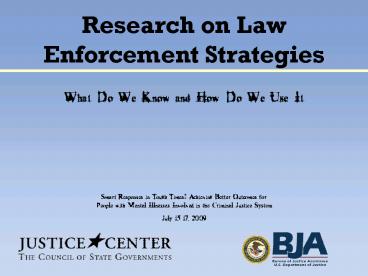Research on Law Enforcement Strategies - PowerPoint PPT Presentation
1 / 11
Title:
Research on Law Enforcement Strategies
Description:
What Do We Know and How Do We Use It ... People with Mental Illnesses Involved in the ... Are we doing what we intended to do? Is what we are doing working? ... – PowerPoint PPT presentation
Number of Views:38
Avg rating:3.0/5.0
Title: Research on Law Enforcement Strategies
1
Research on Law Enforcement Strategies
- What Do We Know and How Do We Use It
Smart Responses in Tough Times Achieving Better
Outcomes for People with Mental Illnesses
Involved in the Criminal Justice System July
15-17, 2009
2
Speakers
- Melissa Reuland (melissareuland86_at_gmail.com /
410-377-2264) - Senior Research Consultant
- Police Executive Research Forum CSG Justice
Center - Victoria Cochran
- State Coordinator for Criminal Justice and
Initiatives - Virginia Department of Mental Health, Mental
Retardation and Substance Abuse Services - Sue Martone
- Assistant Deputy Director, Office of Behavioral
Health - Allegheny County (Penn.) Department of Human
Services
3
Who cares about research?
- Funders
- Media
- Partners
- Community
4
Why should I care?
- What should we do?
- Are we doing what we intended to do?
- Is what we are doing working?
5
What do I need to know about the research?
- What data are measured and how
- What common problems exist in the data
6
Reconciling differences in the data
- Arrest rates
- Calls for service
- Total law enforcement contacts
- Number of agencies with programs
7
What can I learn from published research?
- The nature and extent of police encounters with
people with mental illnesses - The impact of specialized programs
8
Nature and extent of police encounters with
people with mental illnesses
- Most law encounters are with people suspected of
committing low-level misdemeanors, or who are
exhibiting nuisance behavior - Some of these encounters may be volatile, but
rarely do officers encounter someone with a
mental illness at risk of harming someone else - Law enforcement encounters involving people with
mental illnesses are relatively infrequent
(accounting for approx. 2-7 of calls for
service) - Officers respond repeatedly to a small subset of
people believed to have mental illnesses
9
Nature and extent of police encounters with
people with mental illnesses
- These encounters are often time-consuming,
especially when the officer transports the
individual to an emergency medical facility and
waits for admission or medical clearance - Violent outcomes are relatively rare, but these
encounters can present risk s - Officers handle majority of these calls
informally without taking the person into custody
or connecting them to treatment
10
Outcomes achieved with specialized policing
responses
- Decreased injuries to officers
- Increased frequency that officers transport
individuals to mental health facilities for
evaluations and treatment - People referred to treatments have fewer
subsequent contacts with the criminal justice
system - Reduced certain costs incurred by law enforcement
agencies
11
Thank you
- For further information conference
presentations, - please visit www.consensusproject.org
This material was developed by presenters for the
July 2009 event Smart Responses in Tough Times
Achieving Better Outcomes for People with Mental
Illnesses Involved in the Criminal Justice
System. Presentations are not externally
reviewed for form or content and as such, the
statements within reflect the views of the
authors and should not be considered the official
position of the Bureau of Justice Assistance,
Justice Center, the members of the Council of
State Governments, or funding agencies supporting
the work.

